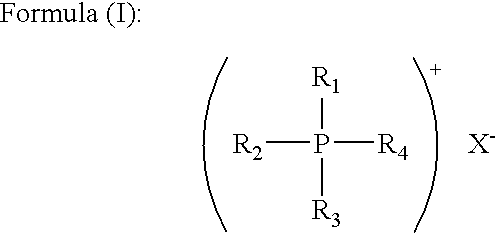Lithographic printing plate precursor, method for preparation of lithographic printing plate precursor, and lithographic printing method
a technology precursor, which is applied in the field method for preparation of lithographic printing plate precursor, and lithographic printing method, can solve the problems of insufficient printing durability, insufficient technique in view of practical printing durability, and extremely weak image strength, and achieve excellent in ink-receptive property and printing durability, and good on-machine development property
- Summary
- Abstract
- Description
- Claims
- Application Information
AI Technical Summary
Benefits of technology
Problems solved by technology
Method used
Image
Examples
example 1
(Preparation of Support)
[0292]An aluminum plate (material: JIS 1050) having a thickness of 0.3 mm was subjected to a degreasing treatment at 50° C. for 30 seconds using a 10% by weight aqueous sodium aluminate solution in order to remove rolling oil on the surface thereof and then grained the surface thereof using three nylon brushes embedded with bundles of nylon bristle having a diameter of 0.3 mm and an aqueous suspension (specific gravity: 1.1 g / cm3) of pumice having a median size of 25 μm, followed by thorough washing with water. The plate was etched by immersing in a 25% by weight aqueous sodium hydroxide solution of 45° C. for 9 seconds, washed with water, then immersed in a 20% by weight nitric acid at 60° C. for 20 seconds, and washed with water. The etching amount of the grained surface was about 3 g / m2.
[0293]Then, using an alternating current of 60 Hz, an electrochemical roughening treatment was continuously carried out on the plate. The electrolyte used was a 1% by weigh...
examples 2 to 4
[0303]Lithographic printing plate precursors (2) to (4) were prepared in the same manner as in Example 1 except for using the compounds shown in Table 1 below in place of the tetramethylammonium tetrafluoroborate used in Example 1, respectively.
[0304]
TABLE 1Compound usedExample 2Tetrabutylammonium hexafluorophosphateExample 3Triethanolamine hydrochlorideExample 4Monoethanolamine hydrochloride
example 5
[0305]Coating solution (2) for image-recording layer having the composition shown below was coated on the same support as described in Example 1 by a bar and dried in an oven at 100° C. for 60 seconds to form an image-recording layer having a dry coating amount of 1.5 g / m2. Subsequently, Coating solution (2) for protective layer having the composition shown below was coated on the image-recording layer by a bar and dried in an oven at 120° C. for 60 seconds to form an protective layer having a dry coating amount of 0.24 g / m2, thereby preparing Lithographic printing plate precursor (5).
[0306]
Coating solution (2) for image-recording layerBinder polymer (1) shown above0.162 gPolymerization initiator I-130.150 gPolymerization initiator S-10.100 gInfrared absorbing agent (2) shown below0.030 gPolymerizable compound (Aronics M-215, produced0.385 gby Toagosei Co., Ltd.)Fluorine-based surfactant (1) shown above0.044 gMethyl ethyl ketone1.091 g1-Methoxy-2-propanol8.609 gWater2.425 gFine part...
PUM
| Property | Measurement | Unit |
|---|---|---|
| particle size | aaaaa | aaaaa |
| thickness | aaaaa | aaaaa |
| aspect ratio | aaaaa | aaaaa |
Abstract
Description
Claims
Application Information
 Login to View More
Login to View More - R&D
- Intellectual Property
- Life Sciences
- Materials
- Tech Scout
- Unparalleled Data Quality
- Higher Quality Content
- 60% Fewer Hallucinations
Browse by: Latest US Patents, China's latest patents, Technical Efficacy Thesaurus, Application Domain, Technology Topic, Popular Technical Reports.
© 2025 PatSnap. All rights reserved.Legal|Privacy policy|Modern Slavery Act Transparency Statement|Sitemap|About US| Contact US: help@patsnap.com



